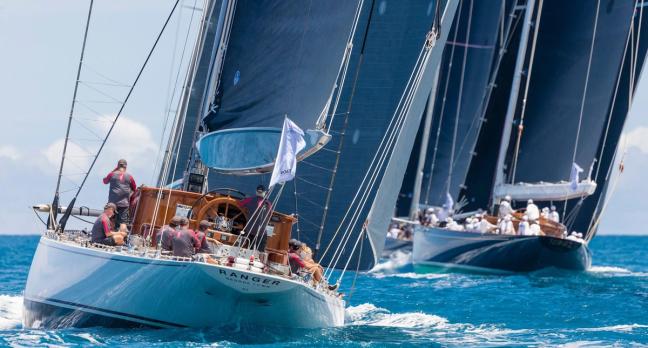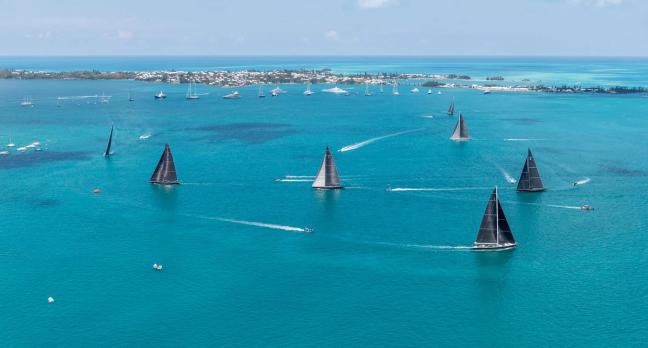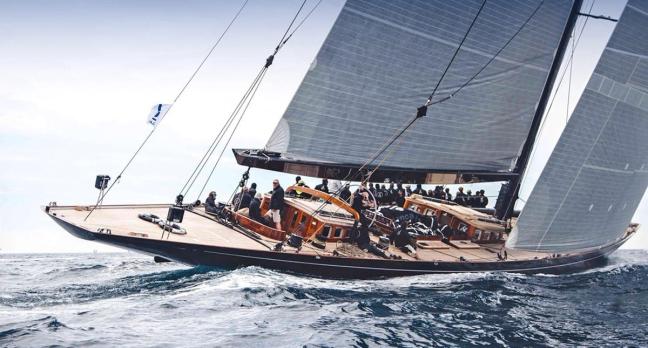“The initial cost isn’t really that much,” I am told by a J Class yacht owner as we stand at the harbour of Hamilton, Bermuda. He clearly senses my scepticism, and is quick to clarify.
“I mean, maybe not as expensive as you may think. The base boat still obviously costs around $10 to 20 million. But the real costs start racking up when you have to pay for the upkeep, which can come in at anywhere up to $3 million every year.”

It’s a painful figure, but J Class yachts – a type of single-masted sailboat that must have either been built in the early 20th Century or produced meticulously to period plans – are beautiful to behold. As we stand, a glass of Cloudy Bay Pelorus sparkling away in our hands, six of these beautiful vessels bob happily next to each other in the harbour. And that’s quite a gathering – there are only nine left on earth.
The history of the awe-inspiring J Class is one as intricately linked with money as it is with engineering prowess and enormous egos. The first, Shamrock V, was built in 1929 by Camper & Nicholsons for Sir Thomas Lipton in his fifth and final attempt to win the America’s Cup – the world’s most famous boat race which was most recently contended by high tech foiling yachts in 2017.
Despite spending $2 million on the endeavour (around $29 million in today’s money), Lipton was unsuccessful. A year later, however, the introduction of the Universal Rule saw the formal formation of the J Class with Shamrock V as its blueprint. By 1937 nine more J Class yachts, including Harold Vanderbilt’s Rainbow, Enterprise and Ranger and Thomas Sopwith’s Endeavour, had been launched.
"The real costs start racking up when you have to pay for the upkeep, which can come in at anywhere up to $3 million every year."
But, despite their beauty, the J Class hey day was not to last. After the 1937 race, the America’s Cup was not held for another 21 years and, by the 1980s, there were just three of the original ten J Class yachts left. This could have been the end of their story, left to rot in remote shipyards, had it not been for Elizabeth Meyer and the International Yacht Restoration School.
Her work restoring the original Endeavour and Velsheda yachts led to the formation of the J Class Association – and it wasn’t long before a new cohort of uber wealthy yacht lovers set about recreating the rest from their original 1930s plans.
Now these majestic titans of sail tour the world competing in specialised races in which the stakes remain as high as ever. The week before my trip to Bermuda these boats competed in the Caribbean in an event which likely saw each individual owner shell out hundreds of thousands for equipment and extra crew. With almost every component of these yachts being custom made, should disaster strike – say your sail shreds during a race (it happens) – you’re looking at the bill the size of an average family home.

Although Lionheart may have taken the crown that time, two of the competitors – Shamrock V and Endeavour – are genuine 1930s boats which more than held their own. Exploring the vessels in the Princess Marina is incredibly exciting, with worn wooden decks and burnished brass fittings giving the yachts a truly antique feel.
But speaking to the owners is almost as awe-inspiring as stepping aboard the boats themselves. And it isn’t because of their passion for sailing – although they have that by the boatful – but rather their capacity for spending. Granted, these are rich men, dynastic heirs or titans of industry, but they don’t even seem to think twice about spending a million in a month on fixing up their boats.
Not only that, but the owners are more than happy to let this level of expenditure slip under the radar. Whereas most men wouldn’t even be able to buy a new car without posting a few choice snaps on Instagram, these sailors can splash substantial cash on these vessels without as much as sending out a single tweet.

And, while the owners are reticent to reveal too many details about the boats in the Cloudy Bay J Class, there are certain snippets that show just how pricey they can be. One vessel has an entirely mahogany-veneered interior (all taken from one tree), another has en suites tiled throughout in original black-and-white 1930s bathroom tiles and a third has a dedicated wine cellar stuffed – literally – to the gunnels with everything from Te Koko to Te Wahi.
So, next time you watch these 140ft kings of the sea set sail, remember: those base boats may be just a ‘drop in the ocean’, but it’s the decadence below decks which makes racing these superyachts the most expensive hobby on earth.
The Dynamiq GTT 160 will cross the Atlantic with speed and style…
Become a Gentleman’s Journal member. Find out more here.

Become a Gentleman’s Journal Member?
Like the Gentleman’s Journal? Why not join the Clubhouse, a special kind of private club where members receive offers and experiences from hand-picked, premium brands. You will also receive invites to exclusive events, the quarterly print magazine delivered directly to your door and your own membership card.


